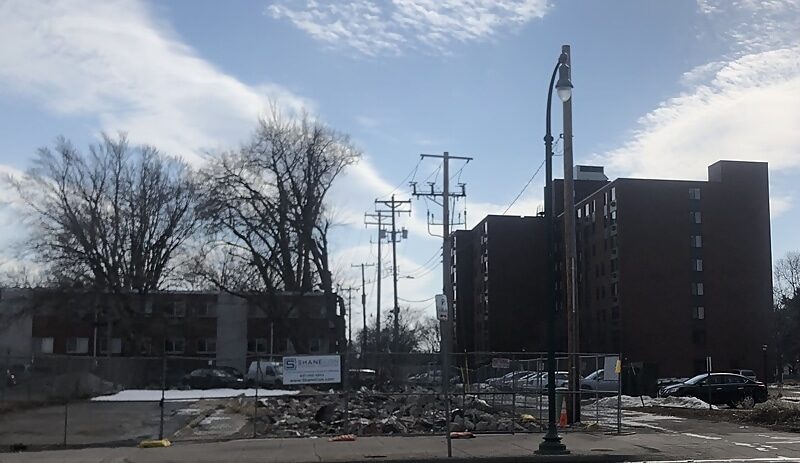A grim tragedy erupted on Saturday night when another man died near what is now called George Floyd Square, an intersection of blocks that serves as a permanent vigil. This time, no police were involved in the killing of the victim, who authorities said died after suffering multiple gunshot wounds.
Kim, who serves as a medic for the "autonomous zone" organized by self-identified Black Lives Matter activists surrounding George Floyd Square, said she heard what sounded like "500 gunshots" during her shift.
"I was first on the scene. Emotions are just so high right now. I've been awake for 36 hours," she told the Washington Examiner. "You picked the wrong day to come here."
Kim said the man was black. Authorities have not identified the victim.
Makeshift barriers and gates surrounded George Floyd Square as of Sunday evening. No white people were allowed access to the area by local activists out of a supposed concern for the "healing" of the community, according to Kim. Those passing by the barricades were waved along and asked to leave, with those manning the gates treating their job as some sort of official duty.
Those kinds of restrictions infuriate locals like Teresa Stiller, who lives just a block away.
Stiller says she and her neighbors tried working with protesters, respecting memorials but asking that traffic flows not be disrupted. In response, she and others were met with threats by people who don't even appear to reside nearby, Stiller said.
"We live here. We want to live here. This isn't their neighborhood. I've had bullets whiz by me right here," Stiller said on the sidewalk outside her home Sunday afternoon. "I have post-traumatic stress disorder now. Whenever I hear a loud noise, I either start crying, or I duck."
Both Stiller and her neighbor from two homes down, Steve, who declined to give his last name, blame an influx of gang violence and protests in South Minneapolis and St. Paul for the constant disruptions to their way of life. The two view Black Lives Matter as the primary culprit, which they say fosters a culture of lawlessness and intimidation against locals.
Minneapolis's rise in crime is undeniable, with law enforcement and the city council arguing over whom to blame. The homicide rate continues spiking as police officers plead for greater funding while local politicians call for a "re-imagining" of law enforcement altogether.
"We're sick of it. I've got guys at the store telling me the Bloods [gang] were helping protect the place because others wanted to come and burn the place down altogether," Steve, a self-identified liberal, said. "Check the [city council] out, with the rookie Mayor [Jacob Frey] and all these people who are comfortable [with what's going on]."
Steve argued that safety concerns have caused people to leave his neighborhood and pointed to the multiple for-sale signs and empty houses up and down the block.
About 10 minutes away, on the commercial East Lake Street, vacant lots filled with rubble served as a reminder of the economic toll caused by last summer's riots. Those streaming out of the rebuilt Target, which now sports pro-Black Lives Matter slogans on its facade, said they don't expect many of the destroyed small businesses ever to come back.
One individual scoffed when asked about the kind of loss developers were suffering amid the backdrop of halfway built condos across the parking lot. Last month, the state passed a bill offering $300 million in bonds to finance small businesses damaged by riots in Minneapolis and St. Paul, a pointless exercise to those like Stiller, who predicted more destruction at the conclusion of former police officer Derek Chauvin's trial for the May 25 killing of Floyd.
To be sure, plenty of residents around George Floyd Square see Black Lives Matter as a mostly peaceful movement. Myriad social justice-themed yard signs on lawns remind outsiders that Minneapolis remains a deep-blue city.
Many, however, struggled to explain their support for the new civil rights movement that coincides with the decline of life so many in the city experience on a daily basis.
"I have safety concerns for my community. You saw this in May and June of last year where over and over again we were seeing cars with out-of-state license plates [causing disorder]," Sarah Homburg, who works in healthcare for the state, said. "I'm seeing a lot of the same chatter about checking in with neighbors and doing patrols again. We should be looking out for each other because we don't feel like the city is looking out for us."
Jury selection for Chauvin's trial begins Monday. City officials promised residents a robust security response in downtown Minneapolis for its duration, with the local government spending millions of dollars on new police officers and protective barricades around the courthouse and city hall.
"The scenario that we're facing right now, this is arguably ... the trial of the year, if not the decade. The dynamics that we faced on the ground in Minneapolis last summer were entirely unprecedented, not just in our city but really nationwide," Frey said at a press conference earlier this month. "The dynamics associated with this trial are going to be difficult and traumatic for so many in our city."
Joseph Simonson is a political reporter for the Washington Examiner, where he covers the 2020 presidential election. Before moving to Washington in 2019, he lived in New York City and worked for the Daily Caller and the New York Post. His writings have appeared in National Review, the Spectator, and the American Conservative. A native of Darien, Connecticut, Simonson is a graduate of Hamilton College.





Comment: The trial is having issues with jury selection due in part to extensive media coverage of George Floyd's death: Man dies when gunfire erupts near 'George Floyd Square' in Minneapolis as Chauvin trial looms